Unusual, spectacular and exciting are all words used to describe the fantastically curious birds of paradise plant. This tropical, evergreen grows wonderfully outdoors and can function as a feature plant indoors.
Although blooms are unlikely when grown indoors, outdoors, this fabulous flora produces breathtaking blooms in fantastic shades of orange, blue and white.
Here is everything you need to know to propagate, care for and grow your very own birds of paradise plant.
More...
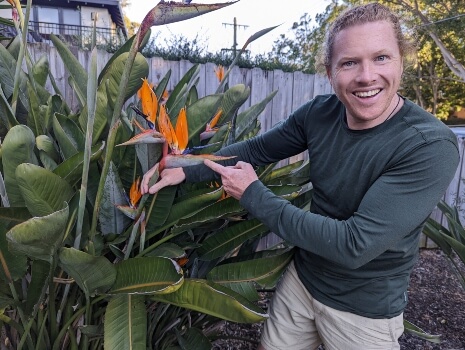
Nathan Schwartz of Aussie Green Thumb with a birds of paradise plant
What is Birds of Paradise?

The birds of paradise plant or crane flower is a South African native but has been grown worldwide for its stunning crane-like flowers. It boasts big, beautiful leathery leaves and can grow anywhere between 3 to 5 metres, depending on the conditions.
While it enjoys a tropical climate best, this feature plant has been known to do quite well, even indoors when provided with enough light.
There are as much as five species of the birds of paradise plant. These are listed in order of the most commonly grown below:
Strelitzia reginae |  |
|---|---|
Strelitzia nicolai Learn how to grow and care for for this variety in our Strelitzia Nicolai | Giant White Bird of Paradise Growing Guide |  |
Strelitzia alba | 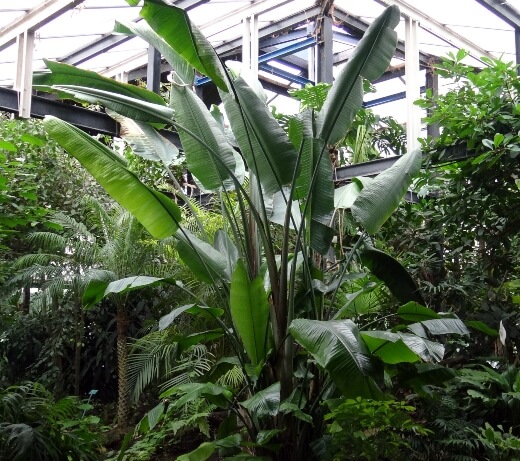 |
Strelitzia caudata |  |
Strelitzia juncea | 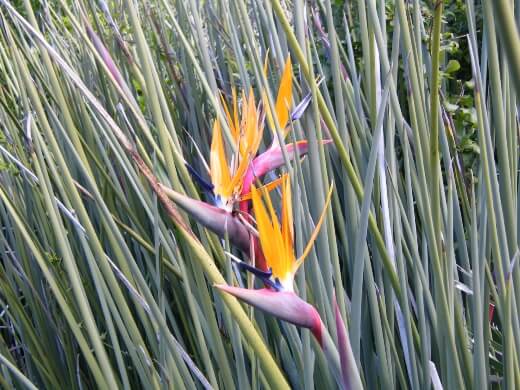 |
How to Grow Birds of Paradise
Depending on where you intend to grow your birds of paradise plant, you’ll need to consider differing conditions. While it can grow happily indoors, it’s important to note that the likelihood of flowering indoors is not very high. Still, that’s no reason not to grow this gorgeous evergreen.

Best Soil for Birds of Paradise
Before propagating or planting, you’ll want to make sure you’re providing your birds of Paradise flower with the right kind of soil conditions. Rich, loam soil is best with a slightly acidic PH level. It’s imperative that your soil will retain moisture but drain properly.
Birds of Paradise Flower Light Preference
In general, your Birds of Paradise plant will enjoy plenty of light, and full sun usually results in more blooms. However, if it’s scorching, a partly shaded spot might be better.
If growing inside, it’s essential to pick a place that gets plenty of light, as this cultivar cannot adapt in low-light conditions and will eventually wilt and die.
How to Propagate Birds of Paradise Plant
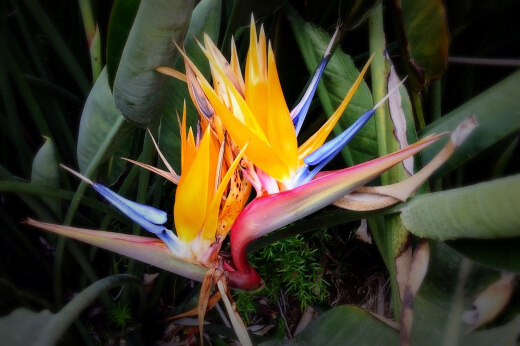
When it comes to propagation, division is the most fool-proof method. Propagation by seed is possible but not recommended. Seeds can take as long as 3 to 5 years to germinate, so it’s not a great option unless you’re really willing to wait.
The best method is to divide by the underground rhizome when re-potting your bird of paradise plant. However, it’s important to note that regularly divided plants will yield fewer flowers each time.
To divide your bird of paradise plant, you’ll want to:


Get Your Free Guide:
Master Growing Australian Natives eBook
A Must Have Complete Guide for Every Australian Garden
Get Your Free Guide:
Master Growing Australian Natives eBook
A Must Have Complete Guide for Every Australian Garden
- Mark out a 30 cm radius around your plant’s base and dig at least 25 to 60 cm deep into the soil.
- Gently pull out the root ball and cut it cleanly with a sterilized grafting knife.
- Slowly disentangle roots and separate the plant.
- Then, re-plant into a pot or different area of your garden.
Your plant should fully mature and begin flowering about 3 to 5 years after division.
Birds of Paradise Care Guide
You will need to maintain certain cultural conditions for a happy plant, especially if you want it to bloom. As the birds of paradise flower enjoys an adequate level of humidity now and then, consider occasionally misting or placing your pot onto a humidity tray, if indoors.
In general, you’ll need to keep up with consistent watering, regular feeding and some light pruning every now and then.
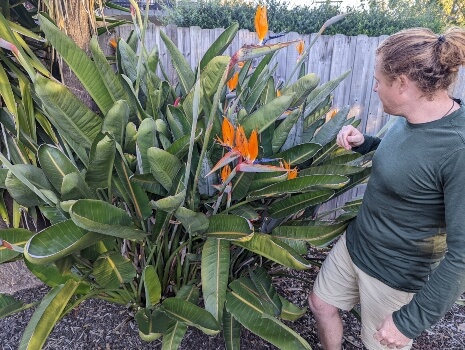
Nathan Schwartz of Aussie Green Thumb examining a Strelitzia reginae
Watering
Your birds of paradise plant will enjoy a solid watering every 1 to 2 weeks. It’s essential, however, to allow the soil to dry out in-between. Ideally, check conditions with a soil probe. If your bird of paradise plant is in full sun, it may need more frequent watering.
While it shouldn’t majorly affect your plant, bird of paradise plants can become quite sensitive to regular tap water. As such, try to use rain or filtered water instead.
Fertilisation
Birds of Paradise plants are heavy feeders, especially in the growing season between spring and summer. Feed your bird of paradise plant regularly with some slow-release fertiliser pellets or a water-soluble fertiliser.
Cut back completely in Autumn and Winter.
Pruning
If a mature plant, it can handle a good cutting back after winter, just to stimulate more vigorous growth. Throughout the year, you prune off old or withering leaves.
The stems are quite thick, and kitchen scissors might not do the trick. So, we recommend using a reliable pair of pruning shears/secateurs or garden loppers to get the job done.
If your birds of paradise plant lives indoors, we also recommend rotating your plant regularly to promote even growth. More so, you may want to consider re-potting every 24 to 48 months to keep the soil aerated and nutrient-rich.
Birds of Paradise Problems, Pests and Diseases
Usually, the birds of paradise plant is relatively pest-free. However, should you run into an issue with a common garden pest like aphids, whiteflies or mealybugs, we recommend using a horticultural (neem) oil to tackle the problem.
It’s also important to note that the sap from the bird of paradise plant can be toxic when ingested, so it’s best to keep your plant out of reach from pets and children.
Root Rot
Root rot is a very common disease that affects the Bird of Paradise plant. The cause of this fungal infection is usually soil that isn’t draining properly. You’ll need to amend your water schedule and make sure that you’re not overwatering your plant.
In terms of signs to look out for, the most obvious would be soft and brown roots and you’ll need to inspect your Bird of Paradise plant’s roots if it starts to look unwell.
Since root rot starts in the ground and works its way up the plant, it’s often quite advanced by the time you might even notice it above ground. Rotten roots are usually a dark brown colour and usually start falling off the plant when you pick them up or if you shake the plant.
They might also be quite soft and mushy, and have a bad smell. Have a look at the stem of the plant too. If it looks twisted or abnormally small, or if the colour of the stem is changing these are also signs of root rot.
Another marker can be a lack of new growth on your plant, or if the leaves are yellow and wilting. A lack of flowers and a plant that fails to flourish is often a sign. If you’re wondering how much yellowing of leaves, more than half and leaves that are dropping off the plant are a good guideline.
A wilting Bird of Paradise plant is one that can’t absorb enough water and you’ll notice it usually starts with the leaves lower down on the plant. The root rot infection causes damage and the plant starts to die back in response. You might also notice that the leaf edges start to turn brown. This will eventually cover the whole leaf.
When it comes to treating your Bird of Paradise plant, you’ll need to get rid of any infected roots and other parts of the plant so that the disease doesn’t spread. Use a copper-based fungicide to treat the roots.
Other solutions that have proved to be effective are baking soda and hydrogen peroxide. Before you do any replanting of your Bird of Paradise, it’s a good idea to let the soil dry out and be sure not to over water your plant going forward.
Bacterial Wilt
This disease is caused by a bacteria that comes from the soil. It mainly gets into the roots of the plant. You might notice that the leaf colour becomes a bit dull, and that the leaves are wilting during the day, but look normal again at night.
Eventually the leaves will turn yellow and brown at the edges, start to wither and then die. Keeping soil well-drained helps to protect against this bacteria, but if your Bird of Paradise plant is affected, you can use an appropriate fungicide for treatment.
Barnacle Scale

Nathan Schwartz showing barnacle scales on bird of paradise leaves
This is a type of soft insect that absolutely loves plants like the Bird of Paradise and they feed off the sap from the plant. They produce a sticky residue on the leaves and this then creates sooty mould.
The name of this pest tells you that they look like barnacles and they have a pearl white appearance. You might see some dark spots on their shell and they are tiny, less than a centimetre.
If your plant is under great attack from these pests, the leaves might start to become yellow and start falling off. Check the leaves and bark for the sticky secretions they leave behind, called honeydew.
You can cut off branches that are heavily affected and throw them away. For a less severe case of barnacle scale, you can actually pick off the insects by hand. Alcohol dipped cotton buds or neem oil can be used to coat the affected parts of your Bird of Paradise plant.
Insecticidal soap can be useful if you use it regularly and horticultural oils are also great as they are kind to the environment too. If you want to know if your barnacle scale infestation is under control, check the new growth on the plant as this is usually where the pests like to hang out.
Birds of Paradise Frequently Asked Questions
Why Do Bird of Paradise Leaves Split?
If your leaves are splitting, don’t panic. Splitting leaves is a natural occurrence. It’s usually your plants precaution against wind or done to allow light to lower growing leaves.
Why Are My Birds of Paradise Leaves Turn Brown?
Another common occurrence is something referred to as tipping, where the end of the birds of paradise leaves turns brown or yellow. This is usually a sign of over-watering, over-feeding or due to too much dry and stagnant air.
Why Are My Birds of Paradise Leaves Wilting?
Wilting or curling of leaves is usually a sign of under-watering. Always check your soil to ensure you’re maintaining enough moisture, and consider misting more frequently to help with humidity.
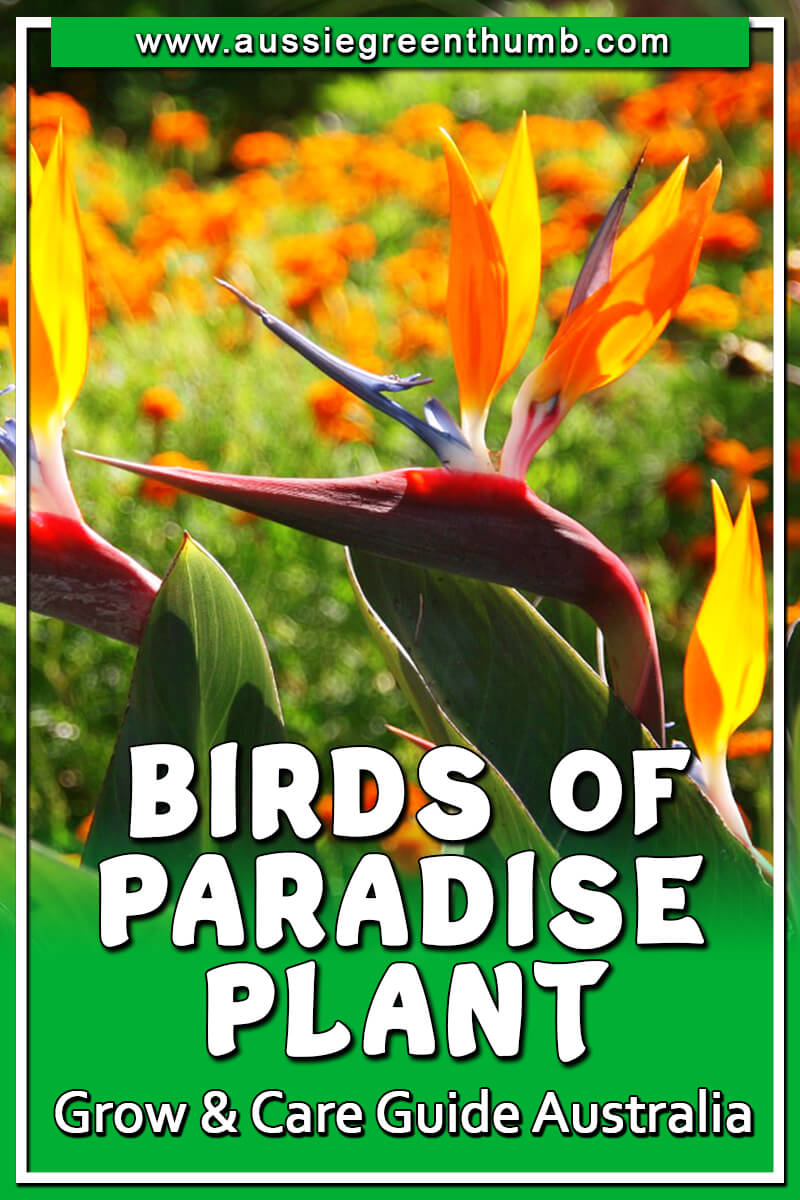
Final Quick Tips for Growing Birds of Paradise Plants
- Remember that if your bird of paradise plant is not getting enough light or moisture, it won’t bloom. This is especially an issue when growing indoors.
- Take the time to regularly dust off the leaves with a damp cloth; this will help boost the photosynthesis process and keep your plant looking crisp and shiny.
- This cultivar is prone to root rot, so take extreme care not to overwater.
- If you are watering with tap water, we recommend letting it sit overnight to the fluoride and chlorine can evaporate.
- This plant is not frost-hardy, so keep it indoors in winter if you can or cover it to protect it from freezing temperatures.
Follow these tips, and you’ll have a beautifully growing and potentially blooming bird of paradise plant. Keep in mind that if growing indoors, it’s going to need a little extra love and a lot more sunlight.
Try to keep your watering consistent, doing using the same amount of water each time. As far as feature plants go, the birds of paradise plant is a perfect option for growers.
Bright, bold and beautiful, you’ll love having a birds of paradise in your home.
Published on December 23, 2022 by Nathan Schwartz
Last Updated on February 2, 2024




